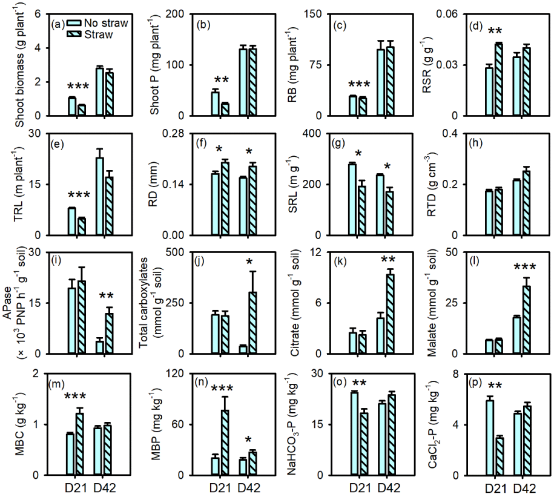Increased Microbial Biomass and Turnover Underpin Efficient Phosphorus Acquisition by Brassica Chinensis

Highlights
lMicrobial P uptake/release caused the shifts in root P-acquisition strategies.
lRepeated additions of organic material increased microbial P pool.
lLarge microbial pool coupling with root acquisitive traits increased crop P uptake.
lStraw amendment governed root-microbe interaction facilitating P-use efficiency.
Root-microbe interactions are critical in influencing crop productivity. Microbial phosphorus (P) mobilization in soil determines P availability to plants, but how plants modify root acquisition strategies in response to microbially mediated P availability remains unknown.
Microbial P immobilization caused by straw addition decreased plant-available P in soil and induced growth of short and thick roots at day 21. In parallel with decline in microbial P in straw-amended soil from the 21st to 42nd day, B. chinensis stimulated root elongation to get close to length of roots without straw. Rhizosphere carboxylate exudation by B. chinensis was greater in the treatment with than without straw at day 42.

Fig. 1 Effects of straw addition on B. chinensis root morphology, root exudation, soil microbial biomass, and plant-available P content. Parameters were measured at day 21 (D21) and 42 (D42) after sowing.
Field experiments with five successive B. chinensis demonstrated P uptake by the first three crops was similar with or without straw addition. However, further repeated straw addition increased soil microbial P pool by one-fold and quantity of phosphate-solubilizing bacterial phoD gene by fifty-eight percent, after the 4th compared with those after the 2nd crop. Phosphorus released from microbial biomass turnover underpinned growth of roots with large specific length and low tissue density that are highly efficient in P acquisition, resulting in increased shoot P accumulation and yield in the 4th and 5th B. chinensis crops.

Fig. 2 Framework of the root-microbe interactions driven by straw addition and the role of these interactions in improving B. chinensis P uptake.
posted by Deshan Zhang from Eco-environment Protection Research Institute

用户登录